The science of AV at the University of East Anglia
The drive for a cross-pollination of ideas has seen a university in the UK spend £30m on a new building to house traditional sciences with computing and engineering.

The need to collaborate, to work together to create new ideas, to find new breakthroughs is irresistible. This was the drive behind the creation of a new £30m (approximately €33) building for the University of East Anglia (UEA) in the UK. The New Science Building is home to Environmental Sciences, Computing, Biology, Physics, Engineering and Chemistry and Pharmacy teaching.
The building was developed to encourage a cross-pollination of ideas and to provide spaces that promote closer interaction and encourage inter-disciplinary collaboration between students.
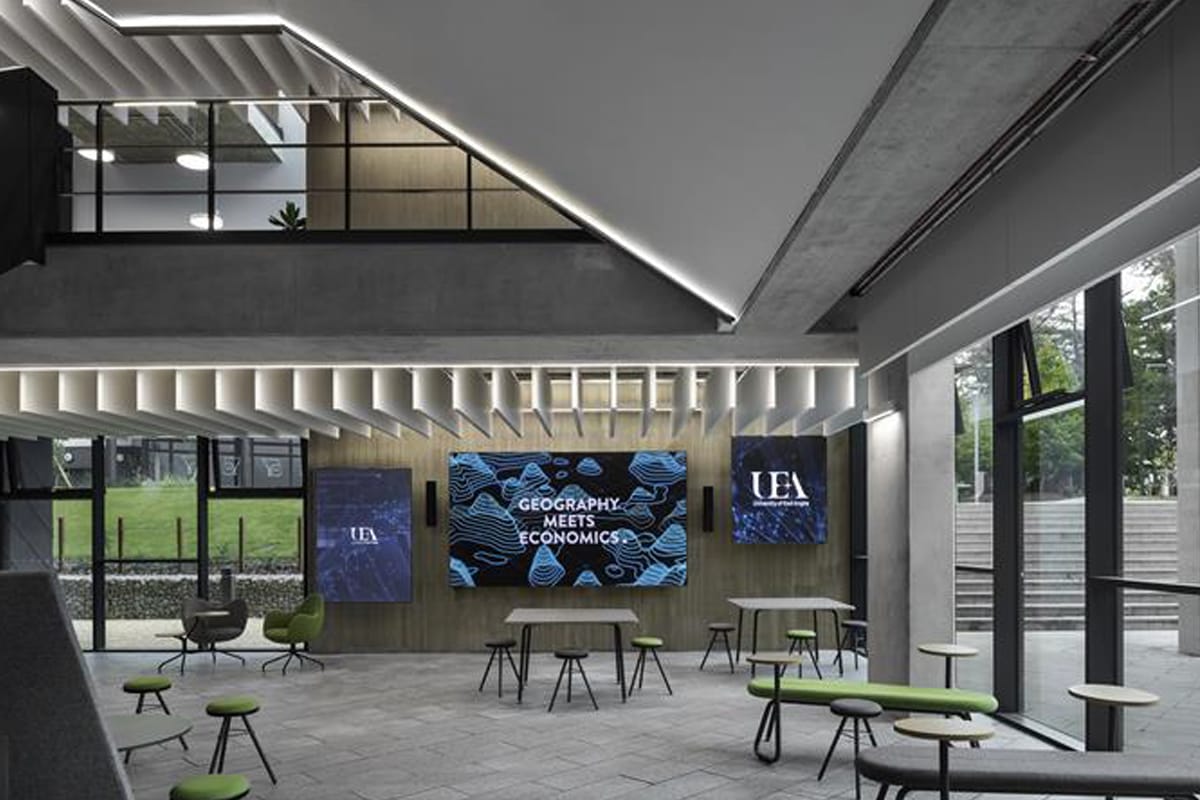
The task of supplying AV to support this goal fell to a long-term partner for the university in local integrator Snelling Business Systems. The AV infrastructure was designed and developed for the purpose of accommodating larger student groups, support concurrent split-use of laboratories, divisible classrooms, common public spaces and avenues for students across the disciplines to interact, share and collaborate with each other.
For example, laboratory spaces can function as one large space to accommodate larger groups comprised of students from across disciplines. For smaller groups, the teacher base location allows multiple options on the touch control panel to switch between the pre-programmed ‘classroom modes’. Locating the general teaching spaces in the same building as the labs encourages a variety of departments to use the building, helping to break down barriers between departments.
The design brief was developed and progressed by Snelling in collaboration with the university’s learning spaces group between 2017 and 2018, with media services (which incorporates the AV department), end users (in the form of faculty) and estates all taking part (the IT department joining the process later on). The client brief was set pretty early on says Steve Royans, sales director, Snelling, “They wanted to be able to do flexible teaching and wanted to be able to share content from students or from the lectern. What later evolved through the use of AV over IP, was the ability to share content between floors as well as actually sending it down to the atrium videowall to give us more flexibility.”
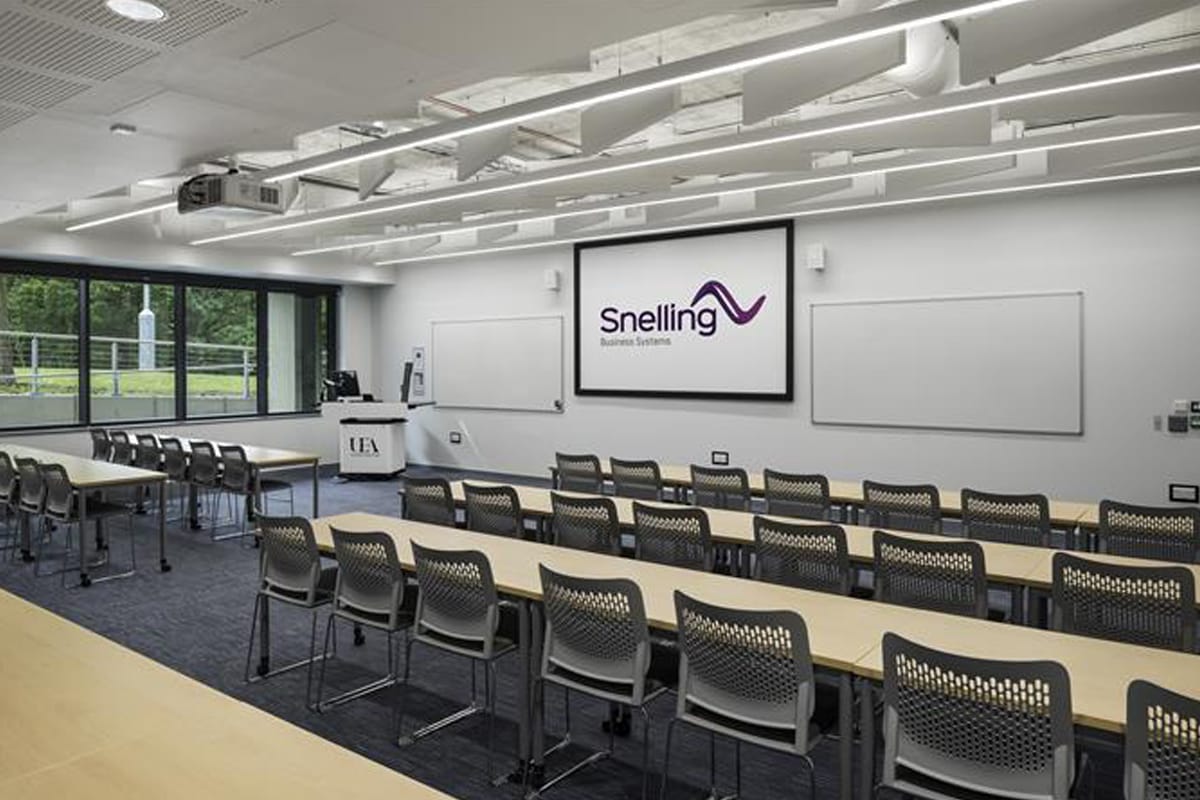
AVoIP is the key to this project but it wasn’t part of the original plan, as Royans explains. “From the early days it was all designed and priced around HDBaseT. Through the course of 2018 we found out that the university was upgrading its IT network across the campus. We had discussions with the IT department on how we could make a converged network. Through workshops we established what their requirements were, and we talked through the benefits of integrating the AV all onto the network.”
The advantages to moving from HDBaseT to AVoIP were instantly clear. From the original plans Snelling removed hardware, added more flexibility, reducing the
total power consumption and the overall cost of the project. The IT was undertaken by the university, with Snelling on hand to consult on how the network should be set up. “Because we have AVoIP traffic, Dante audio plus standard control networks, it sits on a segregated VLAN. It’s all converged on the same switches, it’s just segregated virtually,” adds Royans.
The investment in AVoIP here is a major one, this is the UK’s largest ZeeVee ZyperUHD AVoIP deployment in higher education and a UK first for the technology to be integrated with Extron. The New Science Building includes six Type C classrooms, which range from 24 to 60 seats, and are for small user groups.
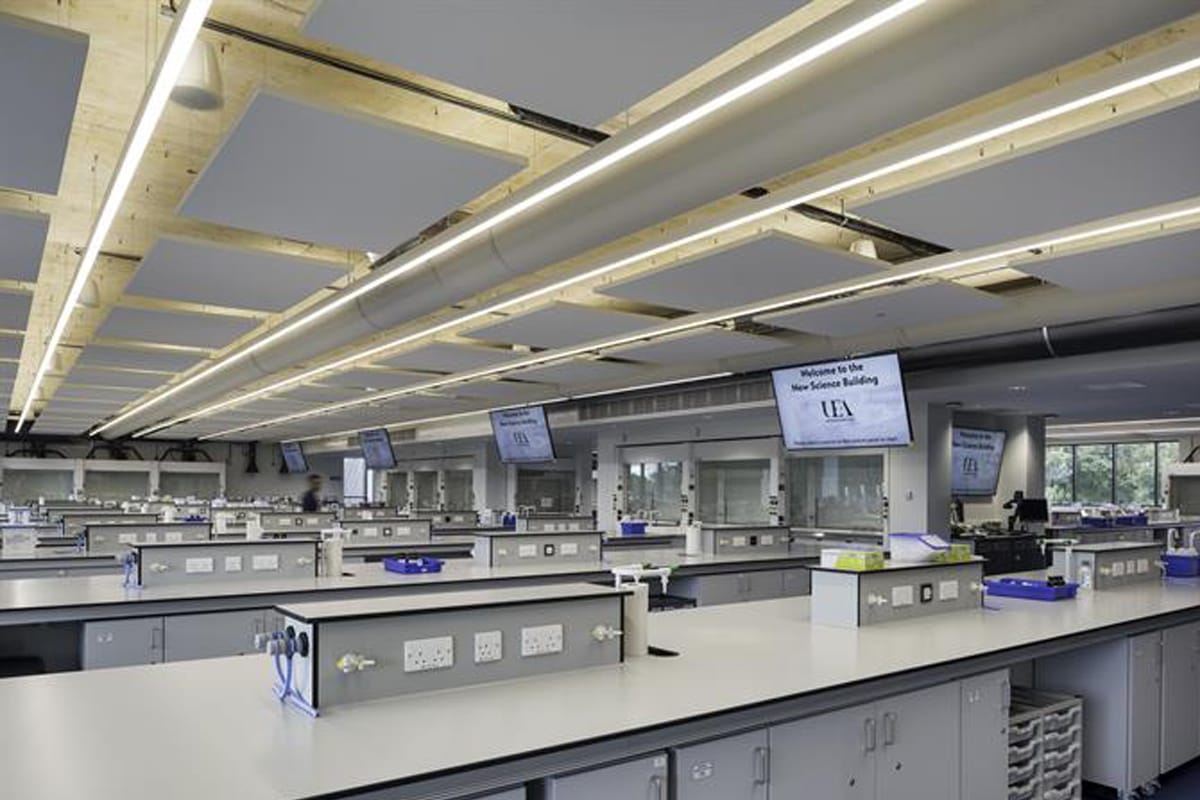
The rooms use single-screen Panasonic projection supported by QSC AcousticDesign ceiling speakers for audio playback (all running via Dante). Height-adjustable lecterns have been installed with a touchscreen-driven all-in-one PC and Extron touch control panel and lecture capture hardware. Also present in the Type C classrooms are Wolfvision visualiser/document cameras, Mersive Solstice Pod wireless presentation software, Ampetronic hearing loop and Panasonic PTZ cameras. The rooms also have VGA/HDMI and USB connectivity.
There are three Type D classrooms, these mid-sized teaching spaces are supported by the identical AV kit as the Type C rooms with the addition of Shure MXW wireless microphones and voice reinforcement to cope with larger groups. Two Type D are divisible and can open up to about 200 seats. The rooms can either be operated individually or as one large seminar space (with a central partition). In this setting, the user can select the pre-programmed setting from either touch control panel to ‘join’ the rooms which will enable audio amplification (microphones and content) through both rooms from either lectern position, and audio (microphones and audio content) through the induction loop. Provision also exists for height-adjustable, trolley-mounted (Teammate VariHite) Panasonic 75-in presentation displays to be connected at the divider location during single-use of the space. The classrooms all follow the same AV path in terms of AV kit because “standardisation was absolutely key on this project,” says Royans.
‘Join’ mode
The two BIO labs are identical, multi-mode laboratories with AV infrastructure to accommodate combined group of students from multiple disciplines. In single-use (called ‘Join’ mode) the lab is used as a single teaching space. The user can select the teaching mode from the control panel at one of either teacher-base location in the lab. Presentation content can be displayed across all screens in the lab with audio (microphones and audio content) delivered throughout the entire lab, as well as through the induction loop. In ‘Split’ mode partitions can be deployed to split each lab into two teaching zones for the delivery of two concurrent teaching sessions.
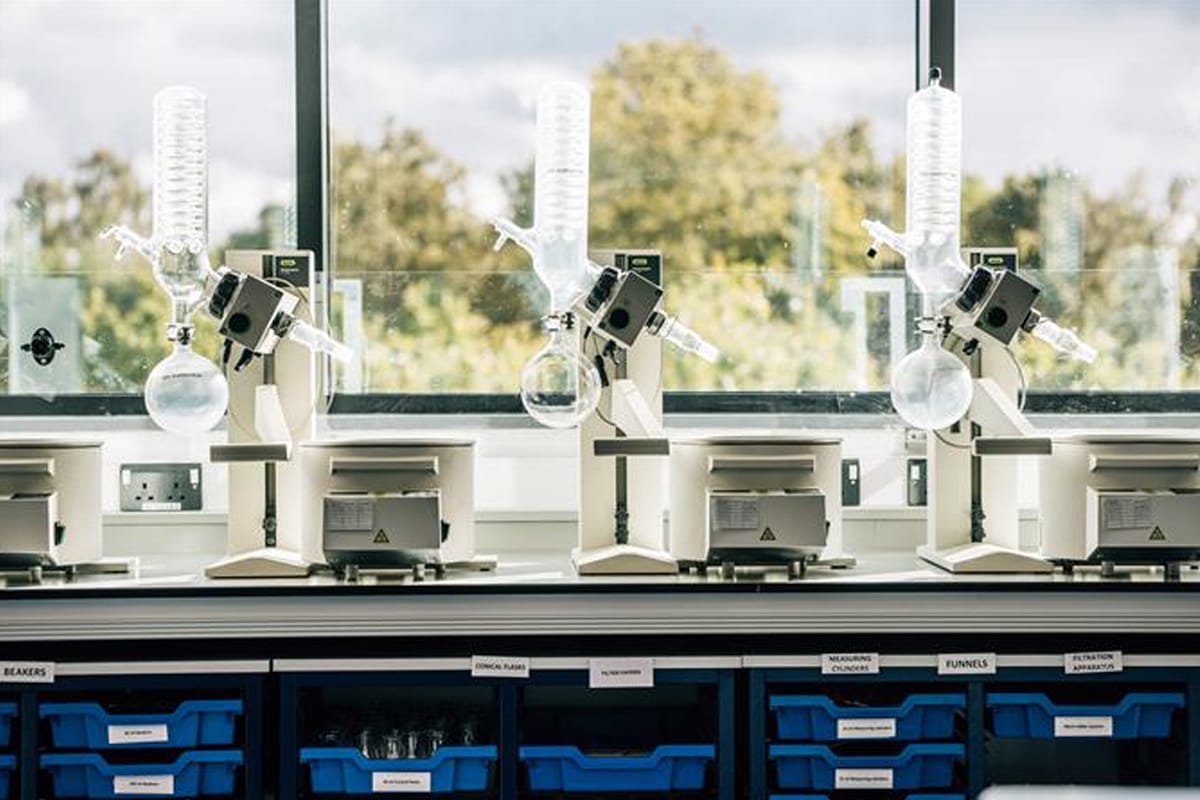
The AV system delivers two independent streams of presentation content from each teacher-base location to the associated display screens in the sectioned zone, as well as splitting the voice reinforcement and audio playback into these two zones. In Multi-Lab Join (‘Multi-Lab’ mode) users have full use of both BIO Lab 1 and BIO Lab 2. Audio and presentation content is delivered to both labs simultaneously, as well as externally to other labs across the building, if required. For security, external broadcasts settings are restricted (and password-protected).
The labs include student benches, which have localised matrices built-in with either 4 screens on extendable arms (12-student bench) or 2 screens (8-student bench) with 2x HDMI inputs at each student position. The main matrix is located at each individual student desk. Each screen location is equipped with a local PC and HDMI input for BYOD provision. Display source selection is controlled via a small button control panel, located at the front of the relevant peninsula.
The lecturer control panel allows the teacher positions to broadcast content onto student screen locations, or a selection of screen locations. In ‘split’ mode, the teacher position can only control screen locations within the partitioned zone. It is also possible to share a student workstation feed (local PC or HDMI input) to any other student workstation in the lab (option available only on the teacher base touch panel).
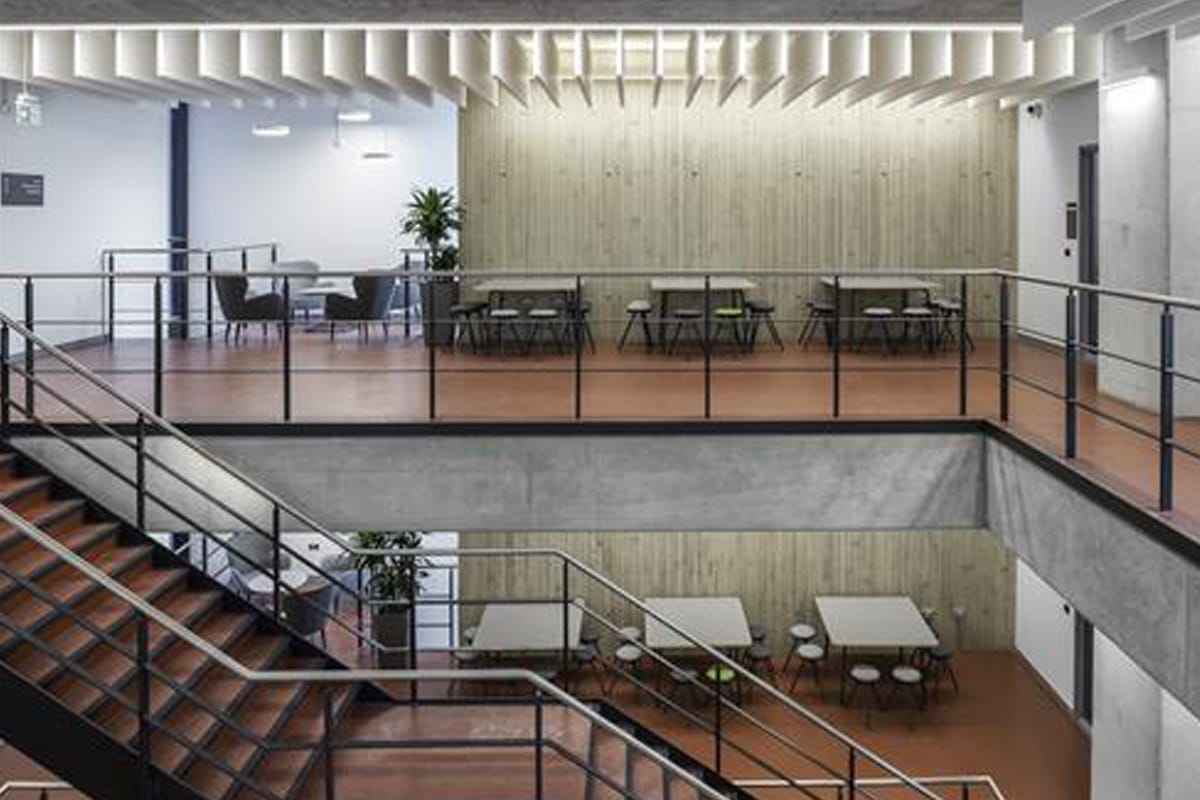
The venue also includes a building-wide broadcast system, with the ability to broadcast live to all other laboratories from one teacher base location in the BIO lab. This feature is used during open-day events and seminars to accommodate large delegations.
The CHEM/PHA Lab is the largest laboratory facility at the new Science Building, which replaces the model of flexibility seen elsewhere, with ‘Join’ mode, ‘Split’ mode and ‘Multi-Lab’ mode all available here too. As is the case for two Adjacent ENV Laboratories as well.
The Atrium features an LED wall façade comprised of three ScanLite screens, which collectively play relevant content for the building’s audience. The LED was a late addition to the project, brought on by the cost saving created by moving to AVoIP. The main LED wall is a 3x2m full HD 1.58mm pitch LED installation, supported by two slightly smaller screens either side. Each LED display is equipped with a ZeeVee Zyper4k decoder, Cabletime signage player, Novastar display controller and QSC column speakers on both sides of the main display. Normally associated with live events or visitor attractions Snelling used Dataton Watchout software to drive the content, Royans explains why; “It sits behind the screens and enables them to have live feeds coming in from elsewhere in the building and the content flow across all three of the screens using the software. We chose it so the students or the media department could create their own content. They can upload it into Watchout free of charge, the students have access to it, and can map and preview the content, and then send that into the media department, and then they can get it on the screen.”
The New Science Building also features digital signage and an IPTV system capable of distributing relevant information and TV signals to specified rooms/areas in the building. Additional large-format display, BYOD and audio installations are also available at smaller labs such as the Tissue Culture and Instrumentation labs.
Stakeholder buy in
“We had engagement from the IT team right away because the university's learning team are actually within the IT department, so there’s really good synergy there,” says Royans. “Lecturers have been very engaged on this project too, they approved the layouts of the control panel, for us it was more about the user experience rather than the actual technology that we're using.” Training sessions on all kit were set up just before handover at the request of the main estates team.
Despite being engaged in the design early on during the project, the biggest challenge on the project says Royans was the late appointment of an integrator for the installation phase. “This had been the first time they’d deployed AV over IP so it required a lot of hand holding from us with IT.” Snelling was able to save itself some time on site however, “One of the benefits of being involved during the design process was that we use BIM modelling which highlighted a number of clashes early on, so we’ve been able to avoid those.”
Going forward Snelling has a service contract for the building, with first line support done through the university’s IT department, with Snelling providing second line support.
“Snelling worked closely with us throughout the entire design process to give us a cutting edge, advanced AV system that fully supports our vision and requirements of students and staff at our New Sciences Building. They worked closely with me to help translate the end user requirements into a technological solution. The key measure of success for me is how easily and seamlessly the end users can take control of the system,” says Matt North, learning spaces technology manager, UEA.
KIT LIST
Audio
Ampetronic d7-2 hearing loop amplifier, ILR3 loop receiver
Extron XPA 1002 amplifiers
QSC AC-S4T-WH, AC-S6T-WH loudspeakers, AD-C4T-LP, AD-C4T-WH ceiling speakers, AD-P4T-WH pendant loudspeakers, SPA2-200, SPA2-60 amplifiers, Core 510i audio processors
Shure CVG12-B/C gooseneck mic, MX391/C boundary mic, WL183 lavalier mic, MXWireless mic
Video
Dataton Watchout software
DVS 4U HYDRA4-WX7100 Pro media server
Extron RGB-HDMI 300 A, IN1606 scalers, IPCP Pro 250 control processors, DXP 84 matrix switchers, SMA-2 touchpanels, iiyama XU2493HS-B1 monitor
Magewell USB Capture HDMI dongle
Mersive Solstice Pod Wireless presentation software
Middle Atlantic RC-2 rackshelf
Panasonic AW-HE40SWEJ9 PTZ camera, PT-MZ570EJ, PT-MZ670EJ, PT-MZ670LBEJ, PT-VMZ40EJ projectors, TH-43LFE8E, TH-55LFE8E, TH-75EF1W flat panel displays
Scanlite 1.5 pixel pitch LED tiles
Screen International FE200X125, FE250X156, FE300X169, FE300X188, FE350X219 projection screens
StarTech ST7300USB3B USB hubs
SY Electronics SY-KP6E-BA keypad controller
TeamMate 260007 educator desk
Unicol mounts
Wolfvision visualisers
ZeeVee ZyPer 4K encoders/decoders, ZHDMPUNL management server
Taken from Inavate. 13 July 2020.
Visit the Inavate website for more information.
Posted: 16th October 2020